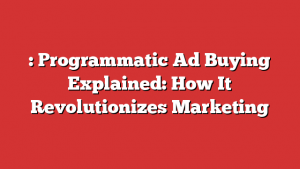- programmatic ad buying explained
- Introduction To Programmatic Ad Buying
- Targeting The Right Audience With Ai And Machine Learning
- Programmatic Ad Buying For Businesses And Enterprises
- Projected Growth Of Programmatic Advertising In The US
- Efficient Selling Of Remnant Ad Inventory Through Programmatic Advertising
- Securing Higher Prices For Premium Inventory Through Programmatic Sales Channels
- Understanding The Process Of Programmatic Ad Buying
- Purchasing Ad Inventory From Multiple Publishers Using A Dsp
- Leveraging Data Management Platforms For Audience Targeting
- Real-Time Bidding Process In Programmatic Advertising
- FAQ
- How does programmatic buying work?
- What is the difference between direct buying and programmatic buying?
- What is programmatic ad spending?
- How does programmatic ad bidding work?
Programmatic ad buying may sound like a complex term, but its benefits are undeniable.
Imagine a world where digital advertising is bought and sold with the aid of artificial intelligence and machine learning.
This revolutionary process promises increased efficiency, pinpoint targeting, and boosted revenue for businesses, advertisers, and publishers.
Join us as we delve into the fascinating world of programmatic adbuying and unravel its mysteries.
| Item | Details |
|---|---|
| Topic | : Programmatic Ad Buying Explained: How It Revolutionizes Marketing |
| Category | DSP |
| Key takeaway | Programmatic ad buying may sound like a complex term, but its benefits are undeniable. |
| Last updated | December 30, 2025 |
buying explained
Programmatic ad buying is the automated process of purchasing and selling digital advertising space.
It uses AI and machine learning to target the most suitable audience.
Advertisers use a demand-side platform (DSP) to automate the buying of ad impressions and can purchase ad inventory from multiple publishers through the DSP.
The DSP uses a data management platform (DMP) to target the right audience based on factors like location, demographics, and user behavior.
Once a person within the target audience lands on a publisher’s website, an ad request is sent to the supply-side platform (SSP), which runs an auction among buyers.
The DSP evaluates and bids for the impression in real-time, and once sold, the impression is displayed on the publisher’s website.
Programmatic advertising provides easy access to ad inventory, allows for better budget utilization, and helps publishers optimize ad sales.
Key Points:
- Programmatic ad buying automates the purchase and sale of digital advertising space using AI and machine learning.
- Advertisers use a demand-side platform (DSP) to buy ad impressions and can purchase from multiple publishers.
- The DSP uses a data management platform (DMP) to target the right audience based on location, demographics, and user behavior.
- A person within the target audience triggers an ad request to the supply-side platform (SSP), which runs an auction among buyers.
- The DSP evaluates and bids for the impression in real-time, and once sold, the impression is displayed on the publisher’s website.
- Programmatic advertising provides easy access to ad inventory, better budget utilization, and helps publishers optimize ad sales.
Check this out:







